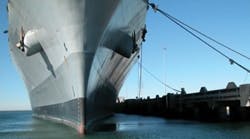To search ship hulls for mines, the U.S. Navy has traditionally employed divers equipped with sonar cameras. The Navy has also trained dolphins and sea lions to search for bombs on and around vessels — but while animals can cover much area quickly, they are costly to care for and train, and don’t always perform as expected. Therefore, Navy scientists and research institutions have been working to engineer robots for mapping cloudy underwater environments on the fly.
Massachusetts Institute of Technology (MIT) graduate student Brendan Englot and Franz Hover, Assistant Professor in the Department of Mechanical Engineering, have designed algorithms that vastly improve such robots’ navigation and feature-mapping capabilities. Using these algorithms, the robot swims around a ship’s hull and views complex structures such as propellers and shafts. The goal is to achieve a resolution fine enough to detect a 10-cm mine attached to the ship.
“A mine this small may not sink the vessel or cause loss of life, but if it bends the shaft, or damages the bearing, you still have a big problem,” Hover says. “Ensuring that a boat doesn’t have a mine attached to it is critical to vessel security today.”
Building on a decade of work, the algorithms program a Hovering Autonomous Underwater Vehicle robot originally developed as part of MIT’s Sea Grant program. In fact, the technology has been commercialized by spinoff Bluefin Robotics Corp., and the MIT engineers have continued to work to improve its performance. The challenge is complex. “It’s not enough to just view the ship from a safe distance,” Hover says. “The vehicle has to go in and fly through the propellers and the rudders, trying to sweep everything, usually with short-range sensors that have a limited field of view.”
First, researchers programmed the robot to approach the ship’s hull from a safe 10-m distance, swimming in a square around the structure. The vehicle’s sonar camera emits signals that boomerang back as the robot makes its way around the ship; researchers then process the sonar signals into a grainy point cloud. To translate this cloud into a solid structure, researchers adapted computer-graphics algorithms to their sonar data, generating a 3D mesh model.
Researchers then programmed the robot to swim closer to the ship, navigating around the structure based on the model. The robot covers every point in the mesh; in this case, each point is spaced 10 cm apart, narrow enough to detect a small mine. The team has tested its algorithms in the field and will conduct more trials this month in Boston Harbor. For more information, visit seagrant.mit.edu.



